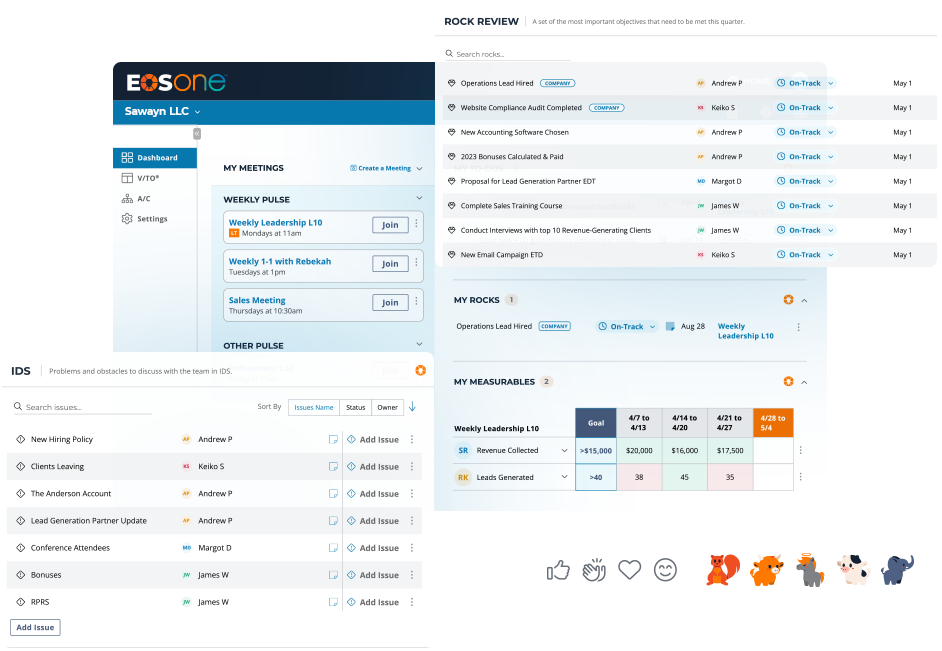“My team knows what to do. They just aren’t doing it.”
As a business owner, how many times have you thought this to yourself or even said it out loud? You’ve hired good people, created detailed plans, and set clear expectations. Yet somehow, tasks still fall through the cracks, deadlines get missed, and promises go unfulfilled.
Many leaders look around and realize no one is accountable for accomplishing their tasks. They wonder how they can create the accountability to build a team that delivers?
After helping many companies throughout West Michigan implement the Entrepreneurial Operating System® (EOS®), I’ve learned most leaders don’t have an accountability problem. They have a system problem.
I know because I’ve been there. Before discovering EOS, I led a team of over 650 people, and despite having talented individuals, we struggled with consistent execution.
Back then, I didn’t understand that creating accountability isn’t about trying harder—it’s about having the right structure.
The Accountability Paradox
When accountability is low, most leaders instinctively tighten their grip. They implement more check-ins, create detailed tracking systems, and increase oversight.
But here’s the fascinating part: These steps often make things worse, not better.
Why?
Because micromanagement doesn’t scale. It burns out both leaders and teams. More importantly, it never addresses the root cause of low accountability.
The real cost shows up in ways you might not expect:
- Missed opportunities because decisions get bottlenecked
- Talented team members leaving due to frustration
- Leaders spending time checking work instead of growing the business
- Teams that can’t scale beyond the owner’s direct oversight
The Three Pillars of True Accountability
Through implementing EOS, I’ve discovered that sustainable accountability rests on three pillars:
- Clear Expectations: Everyone knows exactly what success looks like
- Measurable Outcomes: Progress can be tracked objectively
- Consistent Follow-through: Regular rhythm of review and adjustment
When any of these pillars are missing, accountability starts to crumble. But when all three are in place, something remarkable happens: Teams begin to self-manage.
How EOS Creates Natural Accountability
The beauty of EOS is that it provides simple, practical tools that support all three pillars:
The Accountability Chart®
This isn’t your typical org chart. Instead of just showing who reports to whom, The Accountability Chart clearly defines:
- The right structure for your business
- Each person’s key roles
- What they’re accountable for delivering
I recently worked with a manufacturing company where three different people thought they were responsible for quality control. The Accountability Chart cleared up the confusion in one session.
Rocks
Too often, business owners create detailed annual goals… and then put them in a drawer. By breaking big goals into more manageable steps each quarter, owners can achieve their long-term goals.
These quarterly priorities, or Rocks, create clear expectations about what must happen in the next 90 days to move the business forward. When everyone knows their top priorities:
- Decisions become simpler
- Focus improves
- Results follow
Scorecards
Scorecards track the most important numbers that serve as a predictor for business success. Used effectively, they help teams quickly identify gaps and find opportunities for improvement. Every single member of the team should be responsible for reporting at least one measurable on the Scorecard. Because what gets measured gets managed.
Scorecards provide:
- Weekly numbers that predict success
- Early warning signs when things are off track
- Clear visibility for the whole team
Often, using a Scorecard can expose underlying problems. Your Scorecard can provide objective proof of products that aren’t selling and initiatives that aren’t working—so the power is back in your hands to craft real solutions.
The Level 10 Meeting®
A Level 10 Meeting isn’t just another meeting—it’s a weekly rhythm that ensures consistent follow-through. Most people dread meetings. But in Level 10 Meetings, teams solve real issues and maintain accountability in a structured, efficient way. Using a set agenda, Level 10 meetings maximize efficiency. They start on time, end on time, and are always held at the same time each week.
Meetings like these foster open and honest communication, leading to massive breakthroughs. When you hold your team accountable for their numbers, you can identify bottlenecks in your process and how to stop them.
How Accountability Works in Practice
All this sounds great, but how should you get started with your team?
Here’s a simple exercise I use with my clients to begin building accountability. Have each member of your leadership team write down:
- What responsibilities they believe they own
- What responsibilities they think others own
- Where they see gaps or overlaps
The differences in answers might stun you… and they’ll often reveal exactly why you have a breakdown in accountability.
Common Pitfalls to Avoid
In my years of implementing EOS, I’ve seen several patterns that undermine accountability:
- Making measures too complicated (simple, easy-to-locate numbers work better)
- Tracking the wrong measurables (only track what provides a pulse on the business)
- Inconsistent follow-up (accountability requires rhythm)
- Unclear consequences (both positive and negative)
- Not addressing issues promptly (small issues become big problems)
I also encourage business owners not to be too rigid in their Scorecard structure. The most important numbers to a business will change over time and their Scorecard should reflect that.
Creating a Culture of Accountability
True accountability isn’t about punishment—it’s about creating an environment where:
- People take ownership naturally
- Teams solve problems proactively
- Results are predictable and consistent
- Everyone knows exactly what’s expected
The key is starting with structure. When you have the right foundation, accountability becomes part of your culture rather than something you have to force.
Moving Forward
Imagine walking into your business knowing that:
- Every team member understands exactly what they’re accountable for
- Issues get solved quickly and permanently
- Projects move forward without constant checking
- Your team consistently delivers on their commitments
This is possible—and predictable — when you have the right system in place.
Remember: Accountability doesn’t have to be a struggle. With the right tools and approach, it becomes a natural part of how your team operates. The key is having a simple, clear system that everyone understands and follows consistently.
Need someone to hold you accountable to building a system that delivers for your business? Let’s talk!


